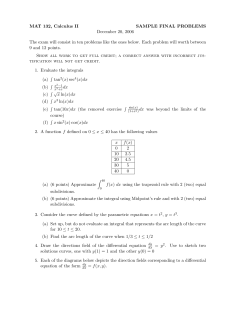
Exercises - The University of Sydney
THE UNIVERSITY OF SYDNEY
Math1901 Differential Calculus (Advanced)
Semester 1
Tutorial Week 3
2015
1. (This question is a preparatory question and should be attempted before the tutorial. Answers are provided at the end of the sheet – please check your work.)
Express the following complex numbers in Cartesian form:
(a) 2cis π4
(b) −4cis π3
(c) cis π2 cis π3 cis π6
(d) e−iπ
(e) eln 2+iπ
(f) e1+i e1−i e−2−iπ
Questions for the tutorial
2. Solve the following equations (leaving your answers in polar form) and plot the solutions
in the complex plane:
√
√
(a) z 5 = 1
(b) z 6 = −1
(c) z 3 + i = 0
(d) z 4 = 8 2 + 8 2 i
3. The complex sine and cosine functions are defined by the formulas
sin z =
eiz − e−iz
,
2i
cos z =
eiz + e−iz
,
2
z ∈ C.
(a) Show that when z is real, sin z and cos z reduce to the familiar real sine and cosine
functions.
(b) Show that cos2 z + sin2 z = 1 for all z ∈ C.
(c) Show that cos(z + w) = cos z cos w − sin z sin w for all z, w ∈ C.
(d) Is it true that | sin z| ≤ 1 and | cos z| ≤ 1, for all z ∈ C?
4. Find all solutions of the following equations:
(a) ez = i
(b) ez = −10
√
(c) ez = −1 − i 3
(d) e2z = −i
5. Let f : C → C be the function z 7→ z 2 . Sketch the following sets, and then sketch their
images under the function f .
(a) A = {z ∈ C | Im(z) = 2}
(b) B = {z ∈ C | Im(z) = 2Re(z)}
(c) C = {z ∈ C | |z| = 1 and Im(z) ≥ 0}
(d) D = {z ∈ C | |z| = 1}
6. Sketch the following sets and their images under the function z 7→ ez :
(a) A = {z ∈ C | 0 < Re(z) < 2, Im(z) = π/2}
(b) B = {z ∈ C | Re(z) = 1, |Im(z)| < π/2}
(c) C = {z ∈ C | Re(z) < 0, π/3 < Im(z) < π}
(d) D = {z = (1 + i)t | t ∈ R}
7. (a) Sketch the set A = {z ∈ C | 1/2 < |z| < 4, 0 ≤ Arg(z) ≤ π/4}.
(b) Sketch the image of A in the w-plane under the function z 7→ 1/z.
(c) An insect is crawling clockwise around the boundary of A in the z-plane. Is its image
(in the w-plane) crawling clockwise, or anticlockwise? (If clockwise, we say the function
is orientation-preserving; if anticlockwise, we say it is orientation-reversing.)
(d) Now consider the function z 7→ z¯. Is this orientation-preserving or orientation-reversing?
8. Find all solutions of the equation e2z − (1 + 3i)ez + i − 2 = 0.
Extra Questions
9. Solve the following equations for z.
(a) z 5 + z 3 − z 2 − 1 = 0, given that z = i is a solution.
(b) z 6 − 4z 5 + 8z 4 − 12z 3 + 5z 2 + 40z − 50 = 0, given that z = 2 + i is a solution.
10. There is a ‘cubic formula’ analogous to the much loved quadratic formula, although it is
a lot more complicated. In this question we start with a warm-up example, before solving
the general cubic equation.
(a) Show that for any complex number z, there exists a nonzero complex number w such
that w + 1/w = z.
(b) Use this substitution to solve the equation z 3 − 3z − 1 = 0.
(c) Generalise the above technique to solve the general cubic
az 3 + bz 2 + cz + d = 0.
Warning: This is a bit labour intensive! It is best to try it outside of tutorial time.
Hint: Try a substitution of the form z = u + α, with α to be determined, to reduce
the equation to the form u3 + pu − q = 0. Now attempt a substitution of the form
u = w + β/w with a cleverly chosen β to reduce the equation to a quadratic in w3 . You
can now solve this equation, hence back-track to find z.
11. Let n be a given positive integer. By a primitive nth root of unity we mean a solution
η of z n = 1 which has the property that its powers η, · · · , η n−1 , η n (= 1) are exactly the
2π
solutions of this equation in C. For example, ei n is a primitive nth root of unity.
(a) Find all primitive 6th roots of unity.
(b) Find all primitive 5th roots of unity.
(c) For which values of k, 0 ≤ k ≤ n − 1, is ei
2πk
n
a primitive nth root of unity?
Solution to Question 1
1. (a) 2cis π/4 =
√
2+
√
2i
√
(b) −4cis π/3 = −2 − 2 3 i
(c) cis (π/2) cis (π/3) cis (π/6) = cis π = −1
(e) eln 2+iπ = eln 2 cis π = −2
(d) e−iπ = cis (−π) = −1
(f) e1+i e1−i e−2−iπ = e1+i+1−i−2−iπ = e−iπ = −1
© Copyright 2025





















